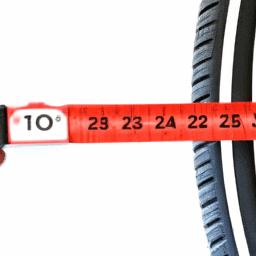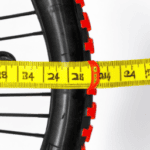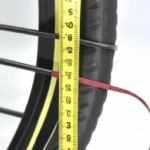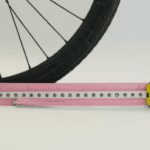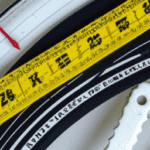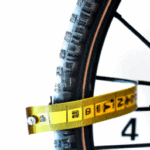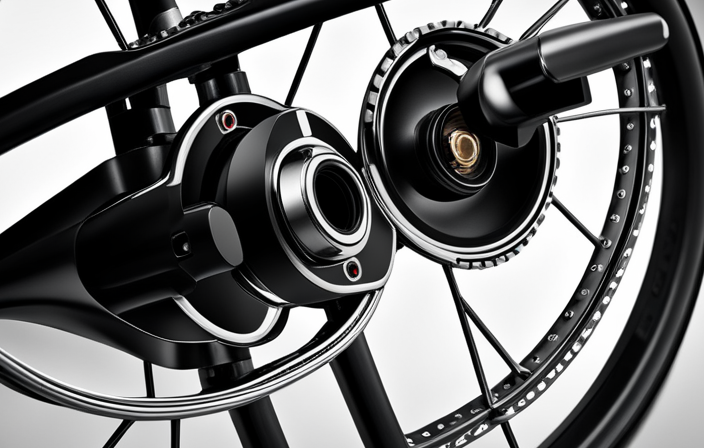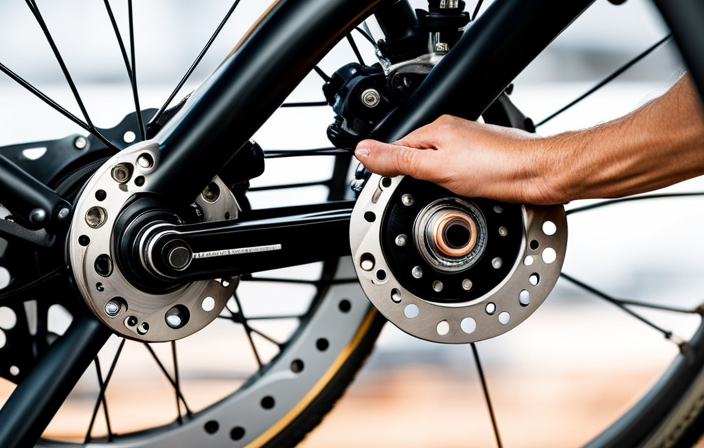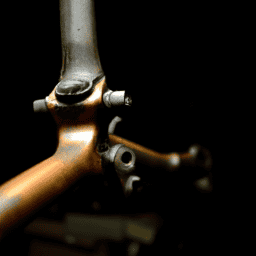Are you a bike rider interested in figuring out the size of your bicycle tires? Whether it’s for the purpose of getting new tires or just for knowing your current tire size for later use, knowing how to measure your tire size is essential. Grasping the specific terms and possessing the right tools will simplify and expedite the process.
In this article, we will walk you through the steps of how to measure your bicycle tire size accurately. Before we get started, it is essential to understand the terminology associated with tire size. Bicycle tire size is typically represented by three numbers: tire diameter, tire width, and rim size. These numbers are usually imprinted on the tire sidewall, but they may be hard to read or may not be present at all.
In this article, we will show you how to measure each of these components accurately to ensure that you purchase the correct tire size for your bike. So, let’s gather the necessary tools and begin the process of measuring your bicycle tire size.
Key Takeaways
- Measuring tire size accurately requires the proper tools, such as a tire gauge and a caliper.
- Tire size is typically represented by three numbers: tire diameter, tire width, and rim size, and can be listed in metric or imperial units of measurement.
- Measuring tire diameter involves calculating the circumference of the tire and dividing it by pi, while measuring tire width involves checking the numbers printed on the sidewall of the tire and measuring the distance between the two edges of the tire.
- Tire manufacturers adhere to tire sizing standards to ensure compatibility with rims of a certain Bead Seat Diameter (BSD), so it’s important to consult a rim size chart and choose the appropriate tire size for your bike.
Understanding Tire Size Terminology
You’ll need to understand the terminology used to describe bicycle tire sizes, including terms like ‘width’ and ‘diameter,’ in order to accurately measure your tire size.
Common tire sizes are usually written on the sidewall of the tire and include a series of numbers and letters that represent the tire’s dimensions. The first number refers to the tire’s width, measured in millimeters from sidewall to sidewall. The second number is the aspect ratio, which is the height of the tire’s sidewall as a percentage of the width. The last number represents the tire’s diameter, measured in inches.
It’s important to note that tire size conversion can differ between metric and standard units of measurement. For example, a tire that is labeled as 26 inches in diameter is equivalent to a metric size of 559 millimeters.
Understanding the different units of measurement and how they correspond to tire size is crucial in accurately measuring your bicycle tire. Now that you have a grasp on the terminology, it’s time to gather the necessary tools.
Gather the Necessary Tools
Grabbing the right tools is key to ensuring a smooth and safe ride on your trusty two-wheeler. When it comes to measuring your bicycle tire size, it’s important to have the right tools handy. The most important tool you’ll need is a tire gauge, which will give you an accurate reading of your tire pressure. In addition to a tire gauge, you’ll also want to have a ruler or tape measure on hand to measure the diameter of your tire.
Accuracy is key when it comes to measuring your bicycle tire size, as even small mistakes can lead to big problems. One common mistake is measuring the width of the tire instead of the diameter, which can lead to incorrect readings. Another mistake is not measuring the tire pressure before measuring the tire size, which can result in inaccurate readings. By using the right tools and taking the time to measure your tire size accurately, you can ensure a safe and comfortable ride on your bike. Now, let’s move on to measuring the diameter of your tire.
Measuring Tire Diameter
Now that we’ve got the necessary tools, let’s take a closer look at how to determine the diameter of your trusty two-wheeler’s rubber wheels.
To calculate the circumference of the tire, you’ll need to measure the distance around the tire’s outer edge. Start by placing a piece of tape on the sidewall of the tire, marking a spot where the tire contacts the ground. Roll the bike forward until the tire completes one full rotation and the tape meets the ground again. Mark this point with another piece of tape.
Measure the distance between the two pieces of tape with a tape measure, making sure to measure in millimeters for accuracy. This measurement is the circumference of the tire.
Once you have the circumference, you can easily calculate the diameter of the tire. Divide the circumference by pi (3.14) to get the diameter of the tire in millimeters. If you’re more comfortable with inches, you can convert the millimeter measurement to inches by dividing by 25.4.
Remember that tire sizes are often listed in metric measurements, so it’s important to be comfortable with both systems.
With the diameter of your tire in hand, you’re now ready to move on to measuring the width of the tire.
Measuring Tire Width
Determining the width of your bike’s rubber wheels is crucial for selecting the right replacement tire. To measure the tire width, start by checking the numbers printed on the sidewall of the tire. The first number indicates the width of the tire in millimeters. For instance, if the number printed on the sidewall reads 25 mm, then the width of the tire is 25 millimeters.
Measuring tire pressure is just as important as measuring tire width. The appropriate tire width is dependent on tire pressure, which is usually indicated on the sidewall of the tire. Once you’ve determined the appropriate tire pressure, use a ruler to measure the distance between the two edges of the tire. This is the tire width.
With the tire width in mind, you can now move on to measuring the rim size.
Measuring Rim Size
To accurately measure the size of your bicycle rim, you need to understand the concept of Bead Seat Diameter (BSD). This is the distance between the two inner edges of the rim where the tire beads sit.
Using a caliper is the most precise way to measure BSD, but you can also use a rim size chart to find the appropriate size. By mastering these techniques, you can ensure that you choose the right tire and tube for your bicycle rim.
Understanding Bead Seat Diameter
Understanding the bead seat diameter is crucial when buying new bicycle tires, as it determines whether or not they will fit properly on your rims. Bead Seat Diameter (BSD) is the diameter of the circle formed by the inner edges of the tire bead seats on the rim. Tire manufacturers adhere to tire sizing standards to ensure that their tires are compatible with rims of a certain BSD. These standards include the ISO, ETRTO, and ANSI, among others.
To determine your bike’s BSD, you can refer to the specifications of your bike or measure it using a caliper. A caliper can measure the distance between the inner edges of the bead seat on the rim. Once you have determined your bike’s BSD, you can confidently purchase the correct size of bicycle tires.
Using a Caliper
Using a caliper is a precise method for gauging the inner diameter of a bike rim’s bead seat. This tool has a high measuring accuracy, ensuring that you get the most accurate tire size measurement possible.
However, there are some common mistakes you should watch out for when using a caliper. First, make sure that the jaws of the caliper are positioned correctly. They should be placed on opposite sides of the bead seat, ensuring that the measurement is taken from the widest part of the rim.
Second, be sure to take several measurements and average them out to ensure that you get the most accurate measurement possible. And finally, make sure that you are measuring the bead seat diameter, not the outer diameter of the rim.
By following these tips, you can use a caliper with confidence to accurately measure your bike tire size.
To further confirm your tire size, using a rim size chart can be another helpful tool. By comparing your bead seat diameter measurement with the corresponding rim size chart, you can determine the appropriate tire size for your bike.
Using a Rim Size Chart
Now that you’ve learned how to measure bicycle tire size using a caliper, let’s move on to another method: using a rim size chart.
This method is ideal if you don’t have a caliper or if you want to double-check your measurements.
The first step in using a rim size chart is to locate the chart for your specific type of bicycle, whether it’s a road bike, mountain bike, or hybrid bike.
The chart will list the rim sizes that are compatible with your bike, along with the corresponding tire sizes.
Comparing tire sizes on the chart will give you a good idea of what size tire you need for your bicycle.
Keep in mind that not all tire sizes will fit on all rims, so it’s important to choose a tire size that is compatible with your rim size.
If you’re unsure, consult with a bike mechanic or do some research online to ensure that you choose the right size.
Additionally, you may need to convert tire size measurements from metric to imperial or vice versa, depending on the chart you’re using.
This is a simple process that can be done using an online conversion tool or by consulting a conversion chart.
Frequently Asked Questions
What is the maximum tire pressure for a specific tire size?
To determine the maximum tire pressure for a specific tire size, consult the manufacturer’s inflation pressure recommendations. Measuring accuracy is crucial for safety and performance. Use a pressure gauge to ensure proper inflation.
Can I use a tire with a different width than the one specified for my bike?
You may choose to use a tire with a width variance from the specs of your bike, but be aware of the handling differences and the impact on speed and performance. Tire width variance should be taken into account.
How do I know if my tire is compatible with my rim size?
To ensure your tire is compatible with your rim, measure the rim diameter and tire width. Factors affecting compatibility include tread pattern and tire construction. Consult your bike’s manual or a professional for further guidance.
Is there a difference between tire size measurements for road bikes and mountain bikes?
Choosing the right tire for your cycling needs requires understanding the differences in Bicycle tire size comparison between road and mountain bikes. For example, a road bike typically has narrower tires than a mountain bike, which requires a wider tire for better traction on rough terrain.
How often should I replace my bike tires?
To maximize safety and performance, replace bike tires every 2-3 years or 2,000-3,000 miles, whichever comes first. Factors influencing tire wear include riding conditions, tire quality, and inflation pressure. Regular tire maintenance is crucial for ensuring longevity and preventing flats.
Conclusion
Now that you’ve measured your bicycle tire size, you can confidently purchase new tires or tubes that will fit your bike perfectly. Remember to always refer to the numbers and letters on the sidewall of your tire to ensure accuracy.
One potential objection to this process may be the perceived difficulty or inconvenience of measuring tire size. However, with the proper tools and knowledge of terminology, measuring your bicycle tire size can be a relatively easy and straightforward process.
Taking the time to accurately measure your tire size can save you time, money, and frustration in the long run, as it ensures that you’re purchasing the correct size tires for your bike.
